Read the Csv and Count Occurences of a Letter
In this Pandas tutorial, you are going to learn how to count occurrences in a column. In that location are occasions in information science when you need to know how many times a given value occurs. This can happen when you, for case, have a limited fix of possible values that you want to compare. Another example tin can be if y'all want to count the number of indistinguishable values in a column. Furthermore, we may desire to count the number of observations at that place is in a gene or we need to know how many men or women there are in the information set, for instance.
Outline
In this post, you will learn how to apply Pandas value_counts() method to count the occurrences in a column in the dataframe. Get-go, we offset by importing the needed packages and then we import case data from a CSV file. Second, nosotros will start looking at the value_counts() method and how nosotros tin can apply this to count distinct occurrences in a column. Third, nosotros volition count the number of occurrences of a specific value in the dataframe. In the last section, we volition accept a await at an culling method that likewise can exist used: the groupby() method together with size() and count(). Now, allow's start by importing Pandas and some case data to play around with!
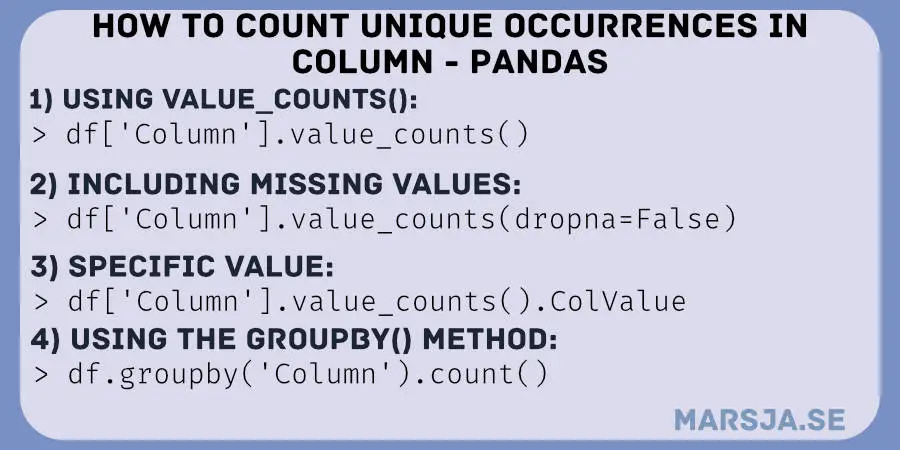
How exercise y'all Count the Number of Occurrences in a data frame?
To count the number of occurrences in eastward.g. a column in a dataframe you can utilize Pandas value_counts() method. For case, if you type df['condition'].value_counts() yous will get the frequency of each unique value in the column "status".
Now, before we use Pandas to count occurrences in a column, we are going to import some information from a .csv file.
Importing the Packages and Information
We utilize Pandas read_csv to import information from a CSV file constitute online:
import pandas as pd # URL to .csv file data_url = 'https://vincentarelbundock.github.io/Rdatasets/csv/carData/Arrests.csv' # Reading the data df = pd.read_csv(data_url, index_col=0)
Code language: Python ( python ) In the lawmaking example to a higher place, we start imported Pandas and then we created a string variable with the URL to the dataset. In the last line of lawmaking, we imported the information and named the dataframe "df". Notation, we used the index_col parameter to set the beginning cavalcade in the .csv file as index column. Briefly explained, each row in this dataset includes details of a person who has been arrested. This means, and is true in many cases, that each row is one ascertainment in the study. If yous store data in other formats refer to the following tutorials:
- How to Read SAS Files in Python with Pandas
- Pandas Excel Tutorial: How to Read and Write Excel files
- How to Read & Write SPSS Files in Python using Pandas
- How to Read SAS Files in Python with Pandas
In this tutorial, nosotros are mainly going to piece of work with the "sex" and "age" columns. It may be obvious but the "sexual practice" column classifies an individual'south gender as male or female. The age is, obviously, referring to a person's age in the dataset. Nosotros can have a quick peek of the dataframe before counting the values in the chosen columns:
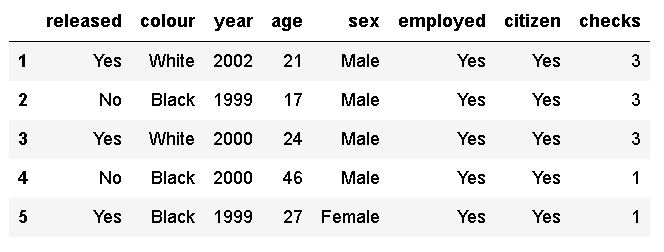
If you have another information source and you can as well add together a new cavalcade to the dataframe. Although, we get some information nearly the dataframe using the head() method you tin can get a listing of column names using the column() method. Many times, we only demand to know the column names when counting values. Notation, if needed you tin can also use Pandas to rename a cavalcade in the dataframe.
Of course, in most cases, you would count occurrences in your own data set but at present we have information to practice counting unique values with. In fact, we volition at present leap right into counting distinct values in the column "sex". That said, we are ready to use Pandas to count occurrences in a column, in our dataset.

How to Count Occurences in a Column with Pandas value_counts()
Here's how to count occurrences (unique values) in a column in Pandas dataframe:
# pandas count distinct values in column df['sex'].value_counts()
Code linguistic communication: Python ( python ) As you can see, nosotros selected the column "sex" using brackets (i.e. df['sexual practice']), and then we just used the value_counts() method. Note, if we want to store the counted values as a variable we can create a new variable. For example, gender_counted = df['sex'].value_counts() would enable the states to fetch the number of men in the dataset by its index (0, in this example).

As yous can see, the method returns the count of all unique values in the given cavalcade in descending order, without whatever null values. By glancing at the above output nosotros can, furthermore, see that there are more men than women in the dataset. In fact, the results evidence u.s.a. that the vast majority are men.
Now, as with many Pandas methods, value_counts() has a couple of parameters that we may find useful at times. For example, if we want the reorder the output such as that the counted values (male person and female, in this instance) are shown in alphabetical gild nosotros can utilize the ascending parameter and set it to Truthful:
# pandas count unique values ascending: df['sex'].value_counts(ascending=True)
Code linguistic communication: Python ( python ) 
Notation, both of the examples above will drib missing values. That is, they will non be counted at all. There are cases, nevertheless, when we may desire to know how many missing values there are in a column equally well. In the next department, we will therefore have a look at another parameter that nosotros can utilize (i.east., dropna). First, all the same, nosotros demand to add a couple of missing values to the dataset:
import numpy as np # Copying the dataframe df_na = df # Adding 10 missing values to the dataset df_na.iloc[[ane, 6, seven, 8, 33, 44, 99, 103, 109, 201], 4] = np.NaN
Code language: Python ( python ) In the code in a higher place, we used Pandas iloc method to select rows and NumPy'southward nan to add together the missing values to these rows that we selected. In the next section, we will count the occurrences including the 10 missing values nosotros added, to a higher place.
Pandas Count Unique Values and Missing Values in a Column
Hither'southward a code example to get the number of unique values besides every bit how many missing values in that location are:
# Counting occurences every bit well equally missing values: df_na['sex'].value_counts(dropna=False)
Code language: Python ( python ) 
Looking at the output we can run across that there are 10 missing values (yes, yes, nosotros already knew that!).
Getting the Relative Frequencies of the Unique Values
Now that we have counted the unique values in a cavalcade we will continue by using some other parameter of the value_counts() method: normalize. Hither's how we become the relative frequencies of men and women in the dataset:
df['sex'].value_counts(normalize=True)
Code language: Python ( python ) 
This may exist useful if nosotros not but want to count the occurrences simply desire to know e.m. what percentage of the sample that are male and female. Before moving on to the next department, allow's get some descriptive statistics of the historic period column by using the describe() method:
df['age'].draw()
Lawmaking linguistic communication: Python ( python ) Naturally, counting age equally nosotros did earlier, with the column containing gender, would not provide any useful data. Here's the data output from the above lawmaking:
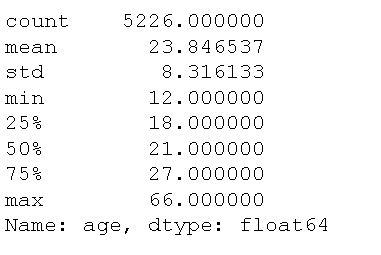
We tin run into that at that place are 5226 values of historic period information, a mean of 23.85, and a standard deviation of 8.32. Naturally, counting the unique values of the age column would produce a lot of headaches but, of course, it could be worse. In the side by side example, we will have a look at counting age and how we can bin the data. This is useful if we desire to count e.grand. continuous data.
Creating Bins when Counting Singled-out Values
Some other cool characteristic of the value_counts() method is that we tin can apply the method to bin continuous data into discrete intervals. Here'due south how we gear up the parameter bins to an integer representing the number of bins to create bins:
# pandas count unique values in bins: df['age'].value_counts(bins=v)
Code language: Python ( python ) 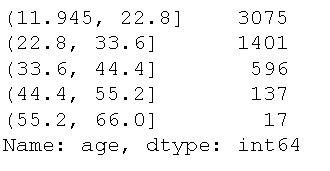
For each bin, the range of historic period values (in years, naturally) is the same. One contains ages from 11.45 to 22.eighty which is a range of x.855. The next bin, on the other hand, contains ages from 22.fourscore to 33.sixty which is a range of 11.8. in this example, you can come across that all ranges hither are roughly the same (except the first, of course). However, each range of age values can comprise a different count of the number of persons within this historic period range. We tin come across that about people, that are arrested are under 22.8, followed past under 33.6. It kind of makes sense, in this example, right? In the adjacent section, we will have a look at how we can utilize count the unique values in all columns in a dataframe.
Count the Frequency of Occurrences Across Multiple Columns
Naturally, it is also possible to count the occurrences in many columns using the value_counts() method. Now, we are going to start past creating a dataframe from a dictionary:
# create a dict of lists data = {'Language':['Python', 'Python', 'Javascript', 'C#', 'PHP'], 'University':['LiU', 'LiU', 'UmU', 'GU','UmU'], 'Historic period':[22, 22, 23, 24, 23]} # Creating a dataframe from the dict df3 = pd.DataFrame(data) df3.head()
Lawmaking language: Python ( python ) 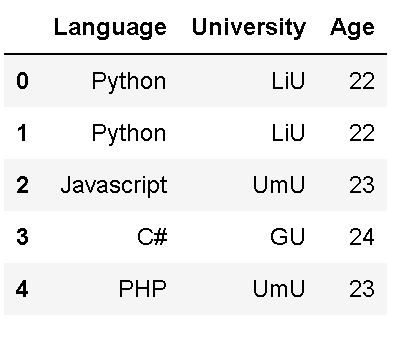
As you can see in the output, higher up, we take a smaller data set which makes it easier to show how to count the frequency of unique values in all columns. If you need, you can convert a NumPy assortment to a Pandas dataframe, too. That said, here's how to use the apply() method:
Code language: Python ( python )
df3.apply(pd.value_counts)
What nosotros did, in the code example above, was to apply the method with the value_counts method equally the merely parameter. This will apply this method to all columns in the Pandas dataframe. However, this really non a feasible approach if we have larger datasets. In fact, the unique counts we get for this rather small dataset is not that readable:
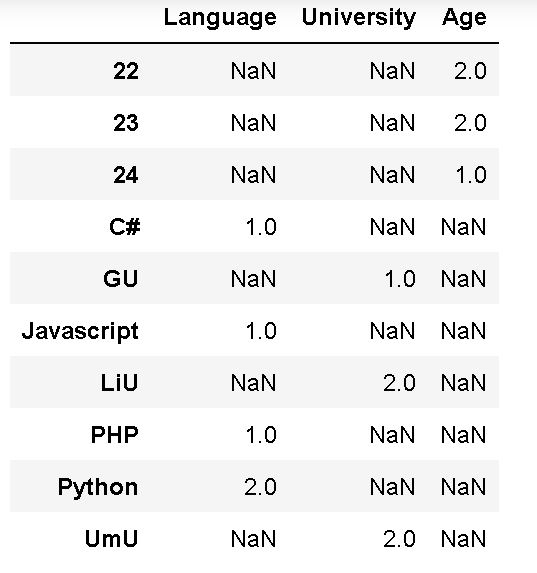
Counting the Occurences of a Specific Value in Pandas Dataframe
It is, of course, also possible to go the number of times a certain value appears in a column. Hither's how to employ Pandas value_counts(), again, to count the occurrences of a specific value in a column:
# Count occurences of sure value (i.eastward. Male) in a cavalcade (i.e., sex) df.sexual practice.value_counts().Male
Code language: Python ( python ) 
In the example above, we used the dataset we imported in the commencement code chunk (i.e., Arrest.csv). Furthermore, we selected the column containing gender and used the value_counts() method. Because we wanted to count the occurrences of a certain value we then selected Male. The output shows u.s. that there are 4783 occurrences of this certain value in the cavalcade.
Every bit often, when working with programming languages, at that place are more than approaches than 1 to solve a trouble. Therefore, in the adjacent instance, we are going to have a look at some culling methods that involve grouping the data by category using Pandas groupby() method.
Counting the Frequency of Occurrences in a Column using Pandas groupby Method
In this section, we are going to acquire how to count the frequency of occurrences across unlike groups. For example, we tin apply size() to count the number of occurrences in a column:
# count unique values with pandas size: df.groupby('sex').size()
Code language: Python ( python ) Another method to go the frequency we can use is the count() method:
# counting unique values with pandas groupby and count: df.groupby('sex').count()
Lawmaking language: Python ( python ) At present, in both examples above, we used the brackets to select the column we want to apply the method on. Only equally in the value_counts() examples we saw before. Note that this produces the exact aforementioned output as using the previous method and to go on your code clean I suggest that yous employ value_counts(). Finally, information technology is too worth mentioning that using the count() method volition produce unique counts, grouped, for each column. This is conspicuously redundant data:

Conclusion: Pandas Count Occurences in Column
In this Pandas tutorial, you have learned how to count occurrences in a column using 1) value_counts() and 2) groupby() together with size() and count(). Specifically, you take learned how to go the frequency of occurrences in ascending and descending club, including missing values, computing the relative frequencies, and binning the counted values.

Source: https://www.marsja.se/pandas-count-occurrences-in-column-unique-values/
0 Response to "Read the Csv and Count Occurences of a Letter"
Отправить комментарий